
Chillis are grown for their attractive market prices. However, they are susceptible to various problems which can result in massive losses. But these issues can be addressed when arrested early enough.
Attack from cut worms
This is a common problem characterised by seedling being cut near the soil surface. When this happens, it indicates presence of cutworms. Handpick the worms from the soil around plants. Keep the garden free of plant debris. Leaves rolling downward with no indication of yellowing or stunting is a physiological leaf roll, not caused by pathogen; it may be a reaction to temperature or weather. Always keep plants evenly watered. No action needed.
Leaves turning yellow
Wilting leaves that turn yellow then brown indicates infestation of whiteflies. Whiteflies are tiny insects that will lift up in a cloud when an infected plant is disturbed. These insects suck juices from plants and weaken them. Spray with insecticidal soap. Trap whiteflies with a sticky bright yellow card.
Curling of leaves
Curling leaves that are deformed and discoloured and stunted plants indicates presence of aphids. Aphids are small soft-bodied insects that are green and gray and cluster on undersides of leaves. The insects leave behind a sticky excrement where a black sooty mould grow. Spray away aphids with a blast of water or use insecticidal soap. Aphid predators include lacewing flies, ladybugs and praying mantis.
Black spots
When leaves turn yellow to brown that is a sign of early blight. Early blight is a fungal disease spread by heavy rainfall and warm temperatures. Keep weeds down in the garden area; they harbour fungal spores. Avoid overhead watering. Small yellow-green raised spots on leaves turn brown and become water soaked; leaves may fall. Bacterial leaf or fungal leaf spot cannot be cured. To avoid it, plant treated seed. It also helps to prune infected leaves, keep garden and tools clean and always plant disease resistant varieties.
Knots
Root knot nematodes are nearly microscopic, translucent worms that inject toxins and bacteria into plant roots. To avoid it, plant resistant varieties and rotate crops. Also companion plant with marigolds. If plants do not grow; blossoms drop off; fruit does not develop. It also helps to plant when the weather is warmer. Also plant varieties recommended for your region.
Water soaked spots
Here, sunken, water-soaked spots develop on blossom end of fruit, spots can turn black and mould may appear. Patches may appear leathery. Blossom end rot is caused by irregular watering or the irregular uptake of water by plants; this can happen when temperatures rise above 32 degrees centigrade. To avoid attacks, keep soil evenly moist and mulch around plants. If the soil has a calcium imbalance that inhibits the uptake of water, to correct situation add limestone if the pH is below 6.0.
Another problem is sunken water-soaked areas on fruit and stems. Fruit may become watery and collapse. This is a sign of Anthracnose, a fungus disease. Remedy is to destroy rotting fruit and keep fruit off soil. Spray or dust with a fixed copper- or sulfur-based fungicide every seven days. Do not collect infected seed. Sunscald can also affect peppers exposed to hot sun. Use shade-cloth or a lath screen to shade peppers during hot spells.
[The writer is an expert on sustainable agriculture]
Want to get latest farming tips and videos?
Join Us
 The Standard Group Plc is a multi-media organization
with investments in media platforms spanning newspaper print operations,
television, radio broadcasting, digital and online services. The Standard Group
is recognized as a leading multi-media house in Kenya with a key influence in
matters of national and international interest.
The Standard Group Plc is a multi-media organization
with investments in media platforms spanning newspaper print operations,
television, radio broadcasting, digital and online services. The Standard Group
is recognized as a leading multi-media house in Kenya with a key influence in
matters of national and international interest.
 The Standard Group Plc is a multi-media organization
with investments in media platforms spanning newspaper print operations,
television, radio broadcasting, digital and online services. The Standard Group
is recognized as a leading multi-media house in Kenya with a key influence in
matters of national and international interest.
The Standard Group Plc is a multi-media organization
with investments in media platforms spanning newspaper print operations,
television, radio broadcasting, digital and online services. The Standard Group
is recognized as a leading multi-media house in Kenya with a key influence in
matters of national and international interest.








